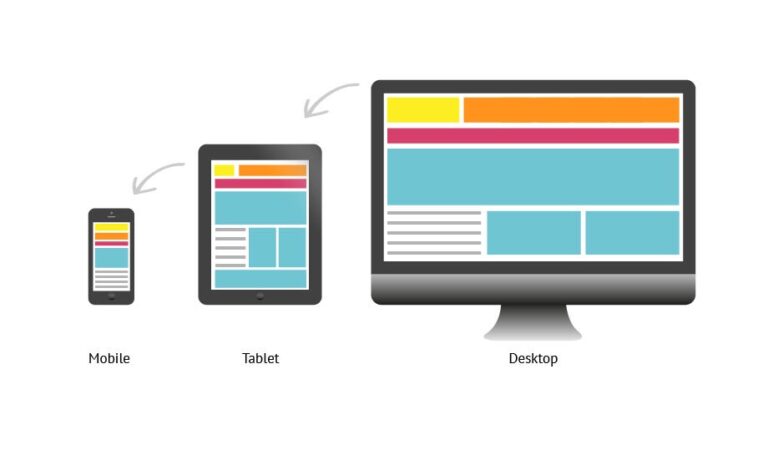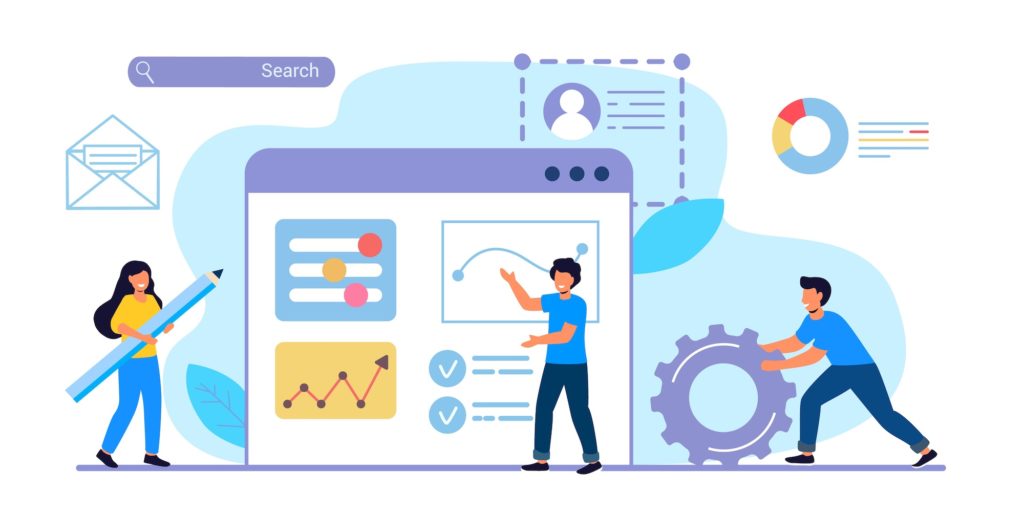Introduction:
Web designs is crucial for several reasons. Firstly, it creates the first impression of a website, impacting how users perceive its credibility and professionalism. A well-designed website enhances user experience, making navigation intuitive and content easily accessible, ultimately increasing engagement and retention. Additionally, effective web design incorporates elements like responsive layouts and fast loading times, ensuring compatibility across devices and optimizing performance for better search engine rankings. Moreover, aesthetically pleasing design can reinforce brand identity and leave a lasting impression on visitors, fostering trust and loyalty. Ultimately, web design plays a pivotal role in shaping the overall success of a website, influencing everything from user satisfaction to conversion rates.
The COVID-19 pandemic has undeniably had a significant impact on the web design industry. With the implementation of new norms such as social distancing and self-quarantining, most potential customers now rely on a company’s website to gather information.
From user experience to digital marketing, SEO results, sales conversions, and return on investment, every aspect of your business will require an optimal web design. Without it, the chances of reaping the benefits in these areas are significantly reduced.
In this article, we will guide you through some common mistakes to avoid when designing or revamping your website. Additionally, we will provide you with effective tips to create a flawless website.
Let’s address these mistakes and embark on the journey of designing an optimal website.
Cluttered Homepage Web Designs:
A cluttered homepage can be detrimental to a website in various ways. Firstly, it overwhelms visitors, making it challenging for them to find the information they need quickly. This can lead to frustration and an increased likelihood of users leaving the site without exploring further. Additionally, cluttered homepages often lack clear hierarchy and organization, making it difficult for visitors to understand the website’s structure and find relevant content. This can result in a poor user experience and reduced engagement, ultimately affecting conversion rates and revenue.
Furthermore, cluttered homepages can diminish a web designs credibility and professionalism. When a homepage is cluttered with excessive text, images, or multimedia elements, it can appear chaotic and unprofessional, undermining trust in the brand. Visitors may perceive the website as amateurish or unreliable, which can damage the reputation of the business or organization.
From a technical perspective, cluttered homepages can also impact website performance. Excessive elements on the homepage can slow down page loading times, leading to a poor user experience and potentially higher bounce rates. Moreover, search engines may penalize websites with cluttered homepages by ranking them lower in search results, as clutter can indicate a lack of quality or relevance.
Overall, a cluttered homepage can have significant negative consequences for a website, including decreased user engagement, lower conversion rates, damage to brand reputation, and potential SEO implications. Therefore, it’s essential for website owners to prioritize clean, organized homepage designs that prioritize usability and user experience.

Decluttering the homepage is essential for improving user experience and maximizing the effectiveness of a website. Firstly, prioritize essential content and information, such as key messages, products, or services, and prominently display them in a clear and concise manner. Use concise headlines and descriptive imagery to convey information quickly and effectively.
Next, streamline navigation by reducing the number of menu items and categorizing content logically. Employ dropdown menus or collapsible sections to organize content hierarchically and reduce clutter on the main navigation bar. Consider utilizing visual cues like icons or hover effects to make navigation intuitive and user-friendly.
Optimize layout and whitespace to create visual breathing room and guide users’ attention to the most important elements. Use generous margins and padding to separate content and avoid overcrowding. Limit the number of elements on the homepage and prioritize high-quality visuals and impactful imagery that align with the brand’s aesthetic.
Poor Navigation Web Designs:
Easy navigation is paramount for the success of a website, as it directly influences user experience, engagement, and conversion rates. Firstly, intuitive navigation enhances usability by allowing visitors to find the information they need quickly and efficiently. Clear and logical navigation menus guide users through the web designs, reducing frustration and increasing satisfaction. This seamless experience encourages users to explore further, leading to higher engagement and prolonged time spent on the site.
Moreover, easy navigation contributes to improved accessibility, ensuring that all users, including those with disabilities or using assistive technologies, can navigate the website with ease. Accessible navigation features such as descriptive link text and keyboard navigation options enable a broader audience to interact with the site effectively, promoting inclusivity and diversity.
In summary, easy navigation is essential for enhancing user experience, accessibility, trustworthiness, conversion rates, and SEO performance. Investing in intuitive navigation web designs is crucial for achieving the goals of a website and maximizing its impact on users and businesses alike.

Improving web designs navigation can be achieved through several strategies. Firstly, simplify menu structures by reducing the number of items and organizing them logically. Incorporate dropdown menus or collapsible sections to create a hierarchical layout that is easy to navigate. Implement descriptive labels for menu items to provide clarity and guidance to users. Secondly, enhance internal linking by strategically placing links within content to facilitate navigation between related pages. Utilize breadcrumbs to show users their current location within the website and provide a clear path back to previous pages.
Thirdly, optimize search functionality by implementing a robust search bar with autocomplete suggestions and filters to help users find specific content quickly. Additionally, consider incorporating navigation aids such as sticky headers or sidebars that remain visible as users scroll, providing constant access to important menu options.
Lack of Mobile Responsiveness Web Designs:
Mobile-friendly web designs is paramount in today’s digital landscape due to the widespread use of smartphones and tablets. With a significant portion of internet traffic originating from mobile devices, ensuring that websites are optimized for mobile screens is essential for reaching and engaging with a diverse audience. Firstly, mobile-friendly design improves user experience by providing a seamless and intuitive interface tailored to smaller screens and touch-based interactions. Responsive design techniques allow websites to adapt fluidly to various screen sizes and orientations, ensuring that content remains accessible and readable across devices.
Moreover, mobile-friendly design is crucial for retaining visitors and reducing bounce rates. Users are more likely to abandon websites that are not optimized for mobile, as they may encounter difficulty navigating or accessing content, leading to frustration and dissatisfaction. By offering a mobile-friendly experience, websites can keep users engaged and encourage longer browsing sessions, ultimately increasing conversion rates and achieving business goals.

Optimizing web designs for mobile devices requires implementing several key strategies. Firstly, adopt responsive web designs techniques to ensure that websites adapt seamlessly to different screen sizes and orientations. This approach allows content to dynamically adjust and rearrange based on the user’s device, providing a consistent and user-friendly experience across desktops, smartphones, and tablets.
Secondly, prioritize performance optimization to enhance loading times on mobile devices, where internet speeds may vary. Compress images and minify code to reduce file sizes and improve page loading speed. Utilize lazy loading techniques to defer the loading of non-critical resources until they are needed, optimizing performance without sacrificing content.
Slow Page Load Speed Web Designs:
Slow loading speed can have significant negative effects on user experience, impacting various aspects of engagement and satisfaction. Firstly, slow-loading websites frustrate users, leading to impatience and a higher likelihood of abandonment. Studies have shown that even minor delays in page loading times can result in increased bounce rates, as users are quick to abandon sites that fail to load promptly. This frustration not only affects the current session but can also deter users from returning in the future, leading to decreased retention and loyalty.
Moreover, slow loading speed diminishes usability by hindering navigation and interaction. Users may encounter delays when trying to access different pages or features, disrupting their browsing flow and impeding their ability to find information efficiently. This can lead to a poor overall experience, as users struggle to complete tasks or achieve their objectives on the website. Additionally, slow-loading websites may exhibit visual inconsistencies or incomplete layouts during the loading process, further undermining usability and professionalism.

Enhancing page speed performance involves implementing various techniques to optimize website loading times and improve user experience. Firstly, optimize images by compressing them without compromising quality. Use image formats like JPEG or WebP and consider lazy loading to defer the loading of off-screen images until they are needed, reducing initial page load times.
Secondly, minify and concatenate CSS, JavaScript, and HTML files to reduce file sizes and minimize the number of server requests. Remove unnecessary whitespace, comments, and code elements to streamline file delivery and improve rendering speed.
Inconsistent Branding Web Designs:
Inconsistent branding can significantly weaken a brand’s identity and impact its overall perception in the eyes of consumers. Firstly, inconsistent branding confuses customers and disrupts the cohesive narrative that a brand aims to convey. When visual elements such as logos, colors, fonts, and messaging vary across different platforms or marketing materials, it creates a sense of disarray and undermines the brand’s ability to communicate a clear and unified message. This lack of coherence can lead to a loss of trust and credibility as consumers may question the brand’s authenticity and reliability.
Moreover, inconsistent branding dilutes brand recognition and diminishes its ability to stand out in a crowded marketplace. Consistency is crucial for building strong brand recognition, as it reinforces visual cues and associations that consumers use to identify and connect with a brand. When branding elements constantly change or deviate from established standards, it becomes more challenging for consumers to recognize and recall the brand, ultimately hindering its ability to establish a strong presence in the minds of consumers.

Maintaining consistent branding across a website involves implementing several key methods to ensure that visual and messaging elements align harmoniously. Firstly, establish brand guidelines that outline the specific rules and standards for branding elements such as logos, colors, fonts, imagery, and tone of voice. These guidelines serve as a reference point for designers, developers, and content creators, ensuring that all website elements adhere to the brand’s identity consistently.
Secondly, use templates and design systems to create a cohesive visual framework for the website. Design systems provide reusable components and patterns that can be applied consistently across different pages and sections, ensuring visual harmony and coherence. Templates help maintain consistency by providing a standardized layout and structure for various types of content, making it easier to maintain a unified brand identity throughout the website.
Conclusion:
In conclusion, avoiding common web designs mistakes is essential for creating a successful and impactful website that effectively engages users and achieves its goals. By steering clear of pitfalls such as cluttered layouts, poor navigation, inconsistent branding, and slow loading times, website owners can enhance user experience, build trust and credibility, and drive better results. Instead, prioritizing clean and intuitive design, streamlined navigation, consistent branding, and optimized performance is key to creating a positive and memorable online experience for visitors. By learning from these mistakes and focusing on best practices, website owners can create websites that not only meet but exceed user expectations, ultimately leading to greater success in the digital landscape.
Discover the Expert Tips For Creating for creating a thriving build a website. Learn the strategies and techniques to build a successful online presence.

Introduction:
Constructing a thriving build a website can bring about numerous advantages for individuals and businesses alike. One key benefit is the ability to reach a wider audience, as a well-designed website can attract visitors from all around the world. This increased visibility can lead to greater brand recognition and potentially more customers or clients. Additionally, having a successful website can help establish credibility and professionalism, as it shows that a business is up-to-date with technology and committed to providing a positive user experience.

Understanding the Basics of Build A Website:
Choosing the right domain name and hosting provider:
Selecting the appropriate domain name and hosting provider build a website is a crucial decision when establishing an online presence. The domain name serves as the unique address for your website, making it essential to choose a name that is easy to remember, relevant to your brand, and reflects the nature of your business. It is important to conduct thorough research to ensure that the domain name you select is not already in use or trademarked by another entity. Additionally, opting for a reputable hosting provider is essential to ensure that your website remains accessible, secure, and performs optimally. Factors to consider when choosing a hosting provider include uptime guarantees, customer support, storage capacity, bandwidth limits, and scalability options.
Selecting a suitable website builder or content management system (CMS):
When it comes to choosing the right website builder or content management system (CMS), it is crucial to carefully consider your options. The selection process involves evaluating various factors such as your specific needs, budget, and technical expertise.
Firstly, you need to assess your requirements and determine what features and functionalities are essential for your website. Consider whether you need e-commerce capabilities, a blog section, or integration with third-party tools. This will help you narrow down your choices and find a website builder or CMS that aligns with your goals.
Secondly, it is important to consider your budget. Some website builders offer free plans with limited features, while others require a subscription or one-time payment. Evaluate your financial resources and choose a platform that not only fits your budget but also provides the necessary tools and support for your website.
Lastly, consider your technical expertise or the resources available to manage your website. Some website builders are user-friendly and require no coding knowledge, making them suitable for beginners. On the other hand, certain CMS platforms offer more flexibility and customization options but may require technical skills or the assistance of a developer.
By carefully evaluating your needs, budget, and technical expertise, you can make an informed decision when selecting a suitable website builder or CMS for your project.
Planning the website structure and navigation:
Designing the layout and organization of the website, as well as determining how users will navigate through the different pages and sections, is a crucial step in the development process. This involves creating a clear hierarchy of information, deciding on the placement of menus and links, and ensuring that the overall structure is intuitive and user-friendly. By carefully planning the website structure and navigation, developers can help users easily find the information they are looking for and enhance their overall browsing experience build a website.
Designing an Engaging and User-Friendly Website:

Importance of a visually appealing and professional design:
A visually appealing and professional design build a website plays a crucial role in capturing the attention of the target audience and leaving a lasting impression. It helps to establish credibility and trust with potential customers, as a well-designed website or product is often perceived as more reliable and reputable. Aesthetically pleasing designs can also enhance user experience, making it easier for visitors to navigate and engage with the content. In today’s competitive market, having a visually appealing and professional design can set a business apart from its competitors and attract more customersbuild a website.
Tips for creating a responsive and mobile-friendly website:
Creating a website that is both responsive and mobile-friendly is crucial in today’s digital landscape. With the increasing use of smartphones and tablets, it is essential to ensure that your website can adapt to different screen sizes and resolutions.
Best practices for organizing content and using clear call-to-actions:
Effective strategies for structuring information and implementing concise prompts are essential for engaging audiences and driving desired actions. build a website employing proven methods for arranging content and crafting compelling calls-to-action, businesses can enhance user experience and increase conversion rates.
Optimizing the Website for Search Engines:

Importance of search engine optimization (SEO) for better visibility:
Search engine optimization (SEO) plays a crucial role in enhancing the visibility of a build a website or online content. By implementing effective SEO strategies, businesses can improve their rankings on search engine result pages (SERPs), making it easier for potential customers to find them.
Techniques for keyword research and on-page optimization:
In the realm of digital marketing, keyword research and on-page optimization play a vital role in driving organic traffic and improving search engine rankings. To enhance these techniques, it is essential to stay updated with the latest trends and best practices in the field.
Strategies for building quality backlinks and improving website authority:
Enhancing website authority and establishing a strong foundation of quality backlinks are crucial strategies for optimizing your online presence. By focusing on building high-quality backlinks, you can significantly improve your website’s credibility and visibility in search engine rankings.
Enhancing User Experience and Website Performance:

Importance of fast loading speed and smooth navigation:
The significance of having a fast loading speed and seamless navigation on a build a website cannot be overstated. Fast loading speed is crucial as it directly impacts user experience. Research has shown that users tend to abandon websites that take too long to load, leading to high bounce rates and loss of potential customers. In today’s fast-paced digital world, users expect instant gratification and are not willing to wait for a slow website to load.
Tips for optimizing images and reducing file sizes:
Strategies for optimizing images and minimizing file sizes can greatly enhance the performance and user experience of a website or application. One effective approach is to resize the images to the appropriate dimensions before uploading them. This ensures that the images are not unnecessarily large and helps to reduce the file size. Additionally, using image compression techniques can further optimize the images without compromising their quality.
Integrating Social Media and Online Marketing:

Utilizing social media platforms to promote the website:
Leveraging various social media platforms to enhance the visibility and reach of the website is a strategic approach to increasing online presence and driving traffic. By utilizing platforms such as Facebook, Instagram, Twitter, and LinkedIn, businesses can engage with a wider audience, share valuable content, and ultimately attract more visitors to their website. Through targeted advertising, engaging posts, and interactive content, companies can effectively promote their website and attract potential customers.
Tips for effective email marketing and lead generation:
Enhancing your email marketing strategies and optimizing lead generation efforts are crucial components of a successful digital marketing campaign. build a website By focusing on creating engaging and personalized content, you can increase open rates and click-through rates, ultimately driving more conversions. Utilizing segmentation and targeting techniques can help you tailor your messages to specific audience segments, increasing the relevance and effectiveness of your emails.
Monitoring and Analyzing Website Performance:

Importance of tracking website analytics and user behavior:
Monitoring website analytics and user behavior is crucial for any online business or organization. By tracking metrics build a website such as website traffic, page views, bounce rates, and conversion rates, businesses can gain valuable insights into the effectiveness of their online presence. Understanding how users interact with a website can help identify areas for improvement, optimize user experience, and ultimately increase conversions and revenue.
Tools and techniques for monitoring website performance:
Monitoring the performance of build a website involves utilizing a variety of tools and techniques to ensure that the site is running smoothly and efficiently. One common tool used for monitoring build a website performance is Google Analytics, which provides valuable insights into website traffic, user behavior, and other key metrics.

Conclusion:
In conclusion, the process of build a website is a crucial step in establishing an online presence for individuals and businesses alike. It provides a platform to showcase products, services, or personal portfolios to a global audience. The website creation process involves several key steps, including planning, design, development, and deployment.
